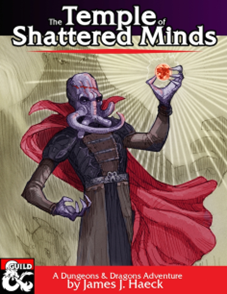 James Haeck’s The Temple of Shattered Minds is an adventure about an elven village that is being preyed upon by an insane mind flayer and his minions. The adventure is written in three parts.
James Haeck’s The Temple of Shattered Minds is an adventure about an elven village that is being preyed upon by an insane mind flayer and his minions. The adventure is written in three parts.
Part I: Alkai Tor describes a village (hamlet?) of humans and elves that has lost most of its members to thralldom and murder. The remaining twenty villagers are paranoid and unsure of what is going on. James takes an interesting approach to this hamlet: each of the NPCs is given a rating of Positive, Neutral or Negative to describe their relationship with the PCs. As the PCs investigate, the villagers change their viewpoints, and a selection of tables describes what then happens at the end of the day: are the PCs tarred and feathered and ordered to leave town, or do they gift the party with magic items and follow their every command? With some of the NPCs inclined to see player actions as making the situation worse, it gives the possibility of some intense role-playing.
There are a few red herrings and other things to make the discovery of the real foes harder. I expect this will be challenging for a DM to run well, but village adventures typically are. Events help push the story along, giving structure and impetus to the story even if the players are completely lost.
Part II: The Border Mire describes the wilderness between the village and the dungeon. There’s another small settlement here that is almost totally under the mind flayer’s control, along with other short encounters to allow the players a glimpse into what’s actually going on.
Part III: The Temple of Shattered Minds describes a temple that was built (and later abandoned) by heretical elves, and now is the lair of the mind flayer. It consists of two levels, both of which are partially underwater (which should amuse the DM and challenge the players).
The adventure’s structure is that of an investigation that turns into a dungeon crawl; an honoured tradition that dates back to Against the Cult of the Reptile God. The investigation is very free-form in nature, with several villagers having competing theories as to who or what is responsible. However, when it comes to physical clues, those are much harder to discover. I would have preferred a much tighter mystery here; there aren’t that many minor clues that slowly lead players to a realisation of what is actually going on. My reading of the adventure is that the most likely way of discovering the culprits is to catch them in the act. I certainly would have preferred a stronger lead to direct the characters in the direction of the dungeon.
The wilderness contains a few major encounter areas, and relies strongly on characters following the trails. One encounter is most likely to occur only if players follow a will-o-the-wisp, which I find a very nice touch.
The dungeon is nicely constructed. It contains a few rather disturbing encounters, as is proper for any adventure employing a mind flayer. The dungeon lacks traps, but does have a number of obstacles and interesting features to investigate, including some that give clues to the identity and state of mind of the adventure’s ultimate foe – assuming the players haven’t worked it out already. And monsters. Yes, it has monsters.
My chief problem with the dungeon is that it – a temple to a strange elven “god” – doesn’t really have that much surviving to indicate its original purpose. It hints that the elves were worshipping a mind flayer(!), but it doesn’t play that up enough. There’s actually a much better idea here than what made it into the final adventure.
What the dungeon does well is establish a few competing factions, and provides the players with the opportunity to interact with them in interesting ways.
The text of the adventure is well-written and nicely edited. The maps are very good, and the artwork wanders between very good and the not so good. It doesn’t detract from the adventure’s other accomplishments. However, the layout of the text on the page suffers from two problems. The first is that there isn’t enough of a gap between the two columns of text. The second is that the spacing between lines is just a bit too large. The net result of this is that I don’t find the text as easy to read as I normally would. It may bother you less.
Overall, Temple of Shattered Minds is an excellent adventure, although a challenging one to run. It’s got a strong central premise, and some suitably fiendish developments along the way to keep the players entertained.
